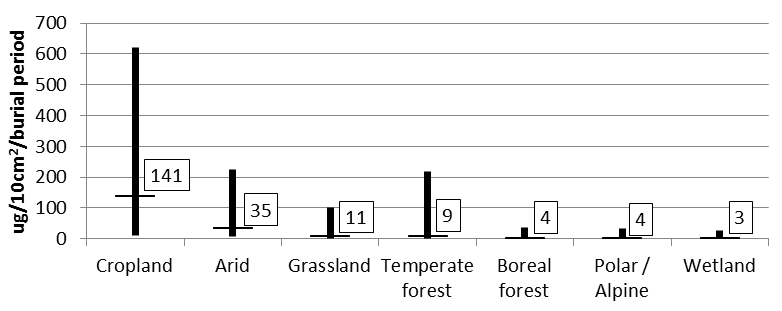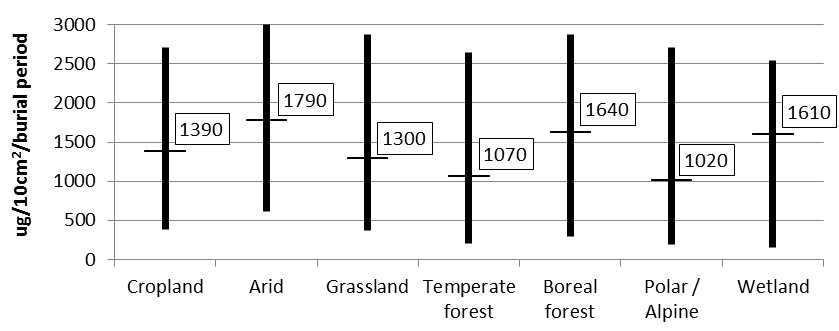Customer Information
Interpretation
Plant Root Simulator (PRS®) Probes have been used for the measurement of soil nutrient supply rate in a wide range of ecosystem types since 1996. A summary of results is provided for the following ecosystems (see notes below):
|
Ecosystem |
Climate |
n ('000s) |
Typical burial period (weeks) |
|
|
Nitrogen |
All |
|||
|
Cropland |
Temperate |
14.9 |
10.4 |
1 to 3 |
|
Arid |
Temperate |
7.0 |
5.0 |
4 to 20 |
|
Grassland |
Temperate |
10.4 |
3.8 |
4 to 12 |
|
Temperate forest |
Temperate |
13.7 |
9.6 |
4 to 12 |
|
Boreal forest |
Boreal |
4.2 |
3.8 |
4 to 20 |
|
Polar / Alpine |
Polar / Alpine |
5.1 |
2.4 |
4 to 24 |
|
Wetland |
Temperate and boreal |
2.8 |
2.7 |
2 to 8 |

Median and 10 to 90% range of NO3-N supply rates in different ecosystems (all burial periods, 1 to 24 weeks).

Median and 10 to 90% range of NH4-N supply rates in different ecosystems (all burial periods, 1 to 24 weeks).

Median and 10 to 90% range of P supply rates in different ecosystems (all burial periods, 1 to 24 weeks).

Median and 10 to 90% range of K supply rates in different ecosystems (all burial periods, 1 to 24 weeks).

Median and 10 to 90% range of S supply rates in different ecosystems (all burial periods, 1 to 24 weeks).

Median and 10 to 90% range of Ca supply rates in different ecosystems (all burial periods, 1 to 24 weeks).

Median and 10 to 90% range of Mg supply rates in different ecosystems (all burial periods, 1 to 24 weeks).

Median and 10 to 90% range of Fe supply rates in different ecosystems (all burial periods, 1 to 24 weeks).

Median and 10 to 90% range of Mn supply rates in different ecosystems (all burial periods, 1 to 24 weeks).

Median and 10 to 90% range of Cu supply rates in different ecosystems (all burial periods, 1 to 24 weeks).

Median and 10 to 90% range of Zn supply rates in different ecosystems (all burial periods, 1 to 24 weeks).
Notes
- Results are based on samples with burial periods ranging from 1 to 24 weeks. Ions will continue to be adsorbed onto PRS® probes until they are in equilibrium with the soil solution, which generally will occur within one or two weeks in moist soils. Ion dynamics depend on both ion and soil properties.
- Approximately 85% of PRS® measurements have been obtained in North America (weighted toward western regions).
- Nutrient supply rates are generally higher in lab burials than in-field burials.
- Nutrient supply rates often positively skewed due to “hotspots” (Johnson et al. 2010, 2011). This occurs both among and within studies.
- NO3-N supply rates often vary considerably over a growing season due to plant uptake and other processes influencing NO3-N bioavailability.
- NH4-N supply rates are low in most soils (close to detection limit). Higher values may occur in acid, waterlogged or recently fertilized soils.
- P supply rates are generally low and sensitive to micro-scale variability due to low mobility.
- K supply rates are moderately high in most soils, but considerably lower than Ca and Mg supply rates. High levels of these divalent cations may limit K supply rate.
- S supply rates are extremely high in moist soils with high levels of SO4-S (e.g., saline soils).
- Supply rates of Ca in mineral soils of temperate regions range from ~1000 to 3000 ug 10 cm-2 burial period-1. Supply rates of Mg are generally about 20% of Ca values.
- Fe, Mn, Cu, and Zn are mostly adsorbed by PRS® anion probes due to addition of EDTA on anion probes and their low mobility as cations. High Fe and Mn levels (> ~ 20 ug cm-2 burial period-1) are indicative of anaerobic and/or acidic conditions. Anaerobic conditions may also increase P, Zn, and Pb supply rates.
